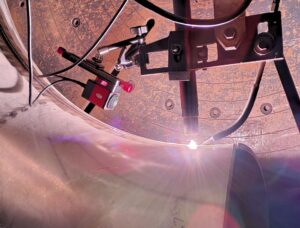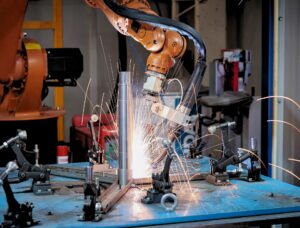Choosing the right welding camera system requires understanding the unique characteristics of your welding process. TIG (Tungsten Inert Gas) and MIG (Metal Inert Gas) welding present distinct monitoring challenges that demand specialized camera solutions. Discover the key differences between TIG and MIG welding camera requirements. Learn which weld monitoring solution best fits your welding process, from arc visibility to data accuracy needs.
Understanding TIG Welding Monitoring Challenges
TIG welding produces a highly concentrated, stable arc that creates specific monitoring requirements:
Arc Characteristics: The TIG arc is typically more stable and concentrated than MIG, but the intense light emission can saturate camera sensors without proper filtering. The arc column is narrower and more defined, requiring high-resolution imaging to capture subtle variations.
Weld Pool Behavior: TIG creates a larger, more fluid weld pool that changes shape gradually. Monitoring systems must track pool oscillations, surface tension variations, and keyhole formation in thick sections.
Filler Metal Addition: Manual or automated filler wire addition creates intermittent obstruction of the weld pool view. Cameras must maintain visibility despite periodic wire interference.
Heat Input Control: TIG welding often uses pulsed current, creating cyclical changes in arc intensity and pool behavior that monitoring systems must interpret correctly.
MIG Welding Monitoring Complexities
MIG welding presents different challenges for camera systems:
Arc Instability: MIG arcs can be less stable than TIG, with more spatter and variable arc length. Monitoring systems must distinguish between normal arc variations and problematic instability.
High Deposition Rates: MIG welding typically deposits metal faster than TIG, requiring cameras that can track rapid weld pool changes and seam progression.
Spatter Management: MIG processes generate more spatter, which can obscure camera lenses and interfere with monitoring. Systems need robust protection and cleaning mechanisms.
Travel Speed Variations: MIG welding often involves higher travel speeds, requiring cameras with sufficient frame rates to capture fast-moving phenomena.
Camera Specifications for TIG Applications
Sensor Requirements: High-resolution sensors (minimum 1920×1080) with excellent low-light performance to capture subtle pool variations during low-heat input phases.
Frame Rates: 60-120 fps typically sufficient for most TIG applications, though high-speed processes may require higher rates.
Filtering Systems: Multi-stage optical filtering to eliminate arc glare while preserving pool visibility. Adjustable filtering for different amperage ranges.
Positioning Flexibility: Adjustable mounting systems to accommodate varying torch angles and joint configurations common in TIG welding.
Camera Specifications for MIG Applications
Sensor Requirements: Robust sensors capable of handling rapid light variations and spatter impacts. Higher dynamic range to capture both bright arc and darker surrounding areas.
Frame Rates: 120-240 fps recommended to capture rapid pool changes and spatter patterns that indicate process stability.
Protection Systems: Enhanced lens protection against spatter, with easy cleaning or replacement capabilities.
Wide Field of View: Ability to monitor larger weld areas typical in MIG applications, including multiple welding stations.
Advanced Features for Both Processes
Intelligent Analytics: AI-powered analysis that learns normal patterns for each process type and flags deviations indicating potential defects.
Multi-Spectral Imaging: Cameras that capture different wavelengths to reveal information not visible in standard imaging.
Integration Capabilities: Seamless connection to welding power sources, robots, and quality management systems.
Environmental Hardening: Industrial-grade construction to withstand harsh welding environments.
Process-Specific Monitoring Parameters
TIG Monitoring Focus Areas:
- Weld pool symmetry and oscillation patterns
- Keyhole formation and stability
- Filler wire feed consistency
- Arc column stability
- Base metal fusion characteristics
MIG Monitoring Focus Areas:
- Arc stability and spatter patterns
- Wire feed consistency
- Weld pool size and shape consistency
- Travel speed optimization
- Penetration adequacy
Selection Criteria Matrix
When choosing between TIG and MIG-optimized camera systems, evaluate:
- Primary Process Type: Systems optimized for your dominant welding process
- Multi-Process Capability: Ability to handle both processes if needed
- Integration Requirements: Compatibility with existing welding equipment
- Environmental Conditions: Protection level needed for your facility
- Analysis Capabilities: Real-time vs. post-process analysis requirements
- Scalability: Ability to expand system as needs grow
Cost Considerations
TIG monitoring systems typically require:
- Higher resolution cameras (higher initial cost)
- More sophisticated filtering systems
- Precision mounting hardware
- Advanced analytics for subtle defect detection
MIG monitoring systems emphasize:
- Rugged construction (higher maintenance costs)
- High-speed capture capabilities
- Robust protection systems
- Spatter management features
Making the Right Choice: TIG and MIG Welding Camera Requirements
The optimal welding camera system aligns with your process requirements, production volume, and quality objectives. Consider consulting with weld monitoring system specialists who can evaluate your specific application and recommend the most suitable solution.
Remember that the best system is one that not only fits your current needs but can adapt as your welding processes evolve and quality requirements become more stringent.
Contact us today to learn how our welding camera solutions can protect your projects, your team, and your bottom line.



